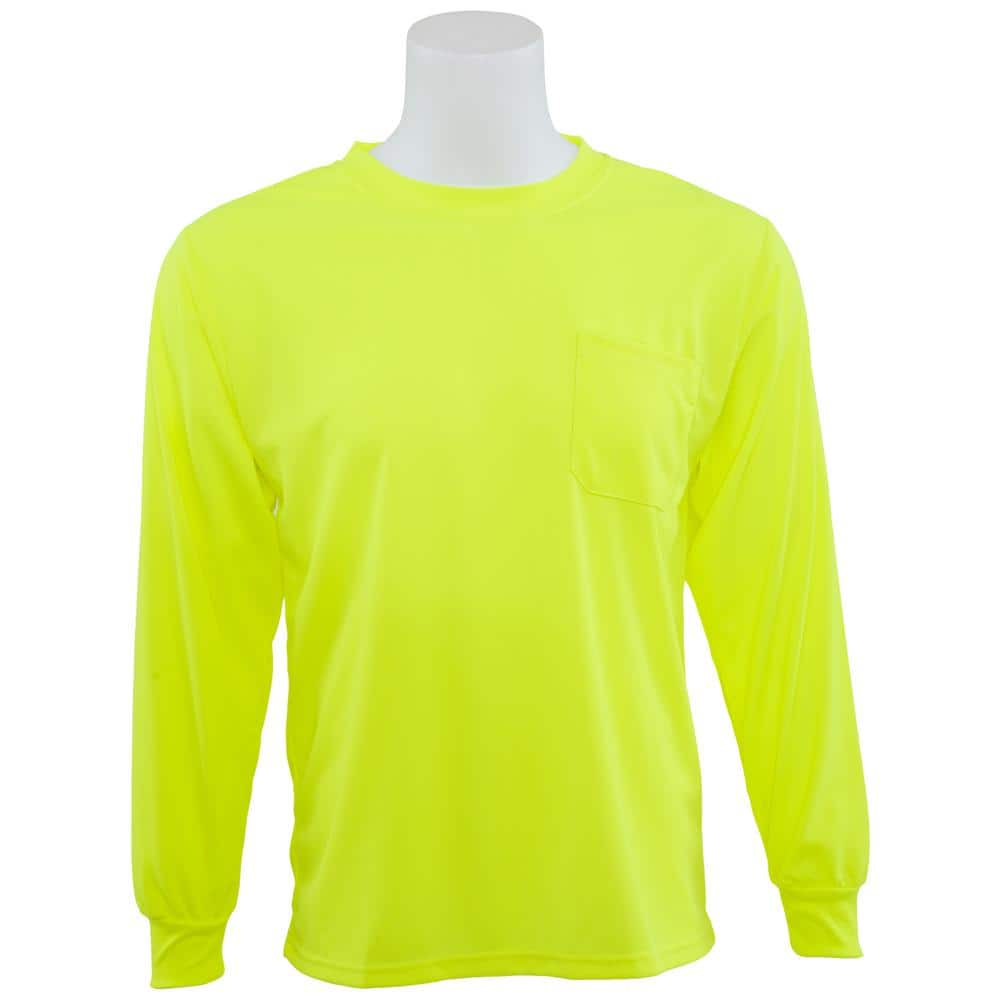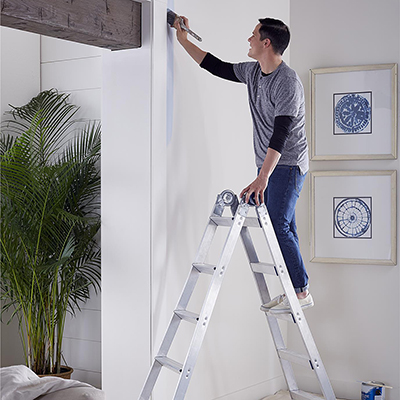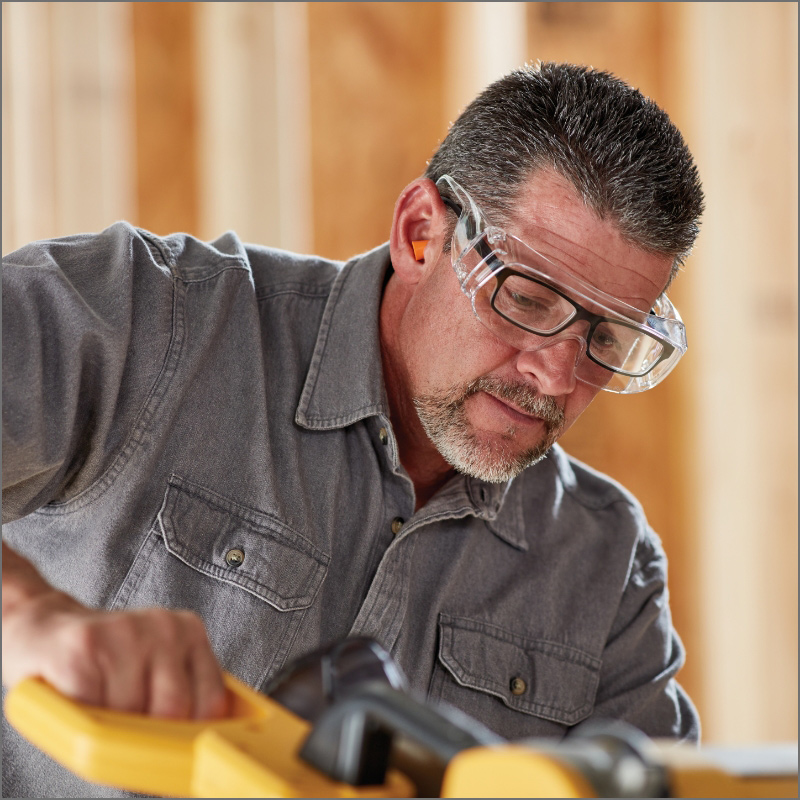What Is PPE and Why Is It Important

Last updated May 9, 2025
Personal Protective Equipment, or PPE, is safety equipment designed to be worn or used by an individual to protect from injury while working. Use of PPE is common among tradespeople on jobsites but DIYers need to use it, too.
This guide will discuss the importance of PPE and help you decide which pieces of gear you need to protect yourself while doing DIY projects.
Sometimes, PPE isn’t intended to protect you from instantaneous serious injury. It may be recommended to help prevent fatigue, skin irritations or repetitive stress injuries.
Table of Contents
Identify the Hazards
Safe Work Practices
Selecting the Right PPE
Eye and Face Protection
Hard Hats and Bump Caps
Breathing Protection, Respirators and Dust Masks
Identify the Hazards

When planning your project, consider the tools and materials that you’ll need. Many will require some level of protection from hazards.
Here are a few partial examples:
- Lumber has splinters, concrete blocks are abrasive, sheet metal edges can cut, so gloves are appropriate.
- Ready mix concrete is abrasive and has ingredients that can irritate skin. The dust is harmful to lungs and eyes. When handling this material, gloves, goggles and a respirator are needed.
- An oscillating multi-tool produces sound above 85db. Hearing protection is needed. It can also throw sparks, splinters and dust, making a dust mask and eye protection necessary.
- A mishap with a chainsaw can cause severe injury. Chainsaw chaps, gloves, steel toe boots and hearing and eye protection are necessary. When working under limbs, a hardhat is needed.
- In many cases, work boots or steel toe boots are appropriate to protect your feet from items that are dropped or are on the floor.
- Some paints, stains and adhesives are harmful to skin. Others are just messy and difficult to clean from skin. In either case, nitrile or other gloves are appropriate. Eye protection can help avoid injury.
Safe Work Practices

Using PPE doesn’t mean you can’t be injured. Care still needs to be taken when working.
For example, there’s no PPE that will prevent a nail from puncturing your hand. You must be careful where you place your support hand before pulling the trigger.
Likewise, the first step to avoiding an eye injury isn’t safety glasses, but knowing how to properly operate a tool and understanding the materials being used.
Check your tools and your PPE for damage before beginning. For example, if the cutoff wheel on the angle grinder is cracked, replace it. A broken wheel can shatter and send pieces flying at great speed. And if your hardhat suspension is damaged, replace it; the hat will not protect your head from a falling object if the suspension system isn’t working.
Closely related is knowing what clothing and PPE is appropriate for a specific job, tool or material. Gloves can protect you from minor abrasions but they can also get tangled in a tool like a table saw. So, gloves would be appropriate for carrying a sheet of plywood, but the gloves need to come off before you cut the plywood on the table saw.
Use your PPE every time.
Selecting the Right PPE

While your DIY project isn’t the same as a professional project, you can take advantage of the rating system that OSHA, the Occupational Safety and Health Administration, requires.
In many cases, PPE in the United States will carry a rating by the ANSI (American National Standards Institute), the ASTM (American Society for Testing and Materials International), the UL (Underwriter’s Laboratories) or other standards bodies. They will refer to specific requirements that can be cross-referenced in their materials to find exact specifications.
Some PPE, like respirator masks, will be rated by NIOSH, the National Institute for Occupational Safety and Health.
These requirements may seem confusing at first, but they don’t have to be. Most of the information you need will be on the product packaging or on the product information page online. Some of these ratings are well known, and you’ll come across them over and over again. An example is ANSI Z87.1+ for impact-rated safety glasses.
This is important information to use the right PPE. A pair of goggles intended only for splash protection will do little to protect your eyes from a shattered grinding wheel.
Eye and Face Protection

The old idea of squinting while you work doesn’t protect your eyes.
- Eye injuries are extremely painful and can result in impaired or lost vision.
- Eye protection is more than just safety glasses; impact-rated glasses are the most widely needed type of eye protection.
- Some situations require goggles for dust, splashes or overspray. Goggles may be rated for impact protection as well, though some are not.
- A full face shield is used to protect your face from grinder debris.
- A welding shield protects your face and eyes from hot sparks and the bright light created by welding.
- A full face vapor respirator, or spray painting mask, will protect your eyes and face as well as provide for air filtration. This is a case where two or more safety functions can be provided by one piece of equipment.
Eye protection is available in tinted varieties for outdoor work, with bifocal lenses for near-sighted vision, sealed frames, ventilated frames, and many other options. You can also get some that fit over your prescription glasses to protect your eyes and your expensive eyewear.
Hard Hats and Bump Caps

When working in areas where things may strike your head from above or the side, a hard hat will protect your head.
- Additional forms of PPE can be attached to a hardhat, like a face shield or earmuffs.
- Hardhats come in several different forms and with various features like vents and chinstraps.
- Different colored hard hats help identify certain trades on a jobsite. If you’re working on a DIY project, just pick the color you like best and wear it with style.
- Hardhats and suspension systems are relatively short-lived. Check the useful service life in the documentation that comes with the hat.
- A bump cap is used when you might bump your head on something, like a suspended pipe or a low doorway.
- Some bump caps are designed to be worn underneath a regular cap.
Breathing Protection, Respirators and Dust Masks

Holding your breath isn’t a safety option. You need a respirator, aka a mask, to protect your lungs.
- It doesn’t seem dangerous, but wood dust suspended in the air can be a sensitizer and cause many issues, including being the cause of new allergies.
- Some species of wood dust are even considered toxic. Spray paint, some cleaning products and vapor for some adhesives are all examples of products that may require use of a respirator.
Breathing protection comes in different varieties for different jobs.
- Everyone knows the ubiquitous N95, which handles most basic dust and nuisance protection. This type of mask filters out particles but doesn’t stop vapors.
- There are many other types of protection that are rated for hazards like sprayed wood finishes or toxic chemicals.
- There are different types. From a simple mask with an elastic band, to a PAPR system that has a filtered blower that brings clean, fresh air into a full-face shield.
- Some respirators have a vent to allow humid, exhaled air to escape. This helps the mask feel cooler and helps prevent the fogging of glasses.
- Facial hair can prevent a mask from sealing properly. In some cases, a full face mask or a PAPR system could be necessary for those with beards.
- The fit and seal of the mask on the face is very important. If air comes in around the mask, it isn’t being filtered and can carry the dust or other substances that need to be kept out.
Tip: Read the label and product information on any mask or replaceable cartridge to find out what hazards it protects against.
Hearing Protection

Hearing loss is cumulative. It’s an oversimplification to put it this way, but every time your ears are exposed to sound over 85 decibels, irreversible damage is done to your hearing. Most power tools and outdoor power equipment exceed that level. The louder the noise, the faster the damage is done.
Early hearing loss is difficult to detect because it begins by losing the ability to hear certain tones rather than not being able to hear at all. Sometimes, tinnitus is the culprit.
The most basic hearing protection are foam plugs or simple, over-the-ear muffs. Other types of protection are variations of these two forms.
- Ear muffs can be integrated with a hard hat. This is another instance of one piece of PPE providing two forms of protection.
- Ear plugs can be loose or connected with a string or other device.
The downside to hearing protection is that it limits an important sense, which can make it difficult to hear the environment around you. However, there are several types of hearing protection that allow ambient sounds to pass through.
- Most are electronic.
- Some allow a wireless connection to a smartphone.
- Some of these smartphone features include a noise-cancelling microphone that allows calls to be made in noisy environments.
Hearing protection is rated with a Noise Reduction Rating, or “NRR,” which tells us how many decibels less you'll be exposed to. All hearing protection needs to be worn properly to achieve the NRR stated. Follow the manufacturer’s instructions for use.
If the tool or equipment produces louder noise than one method of hearing protection can provide, ear plugs and earmuffs can be combined.
Chainsaws and Outdoor Power Equipment

Operating a chainsaw calls for specialized PPE. The hazards of using a chainsaw are often underestimated. They are extremely powerful tools that can cause severe injury, even to experienced users.
- Chainsaw chaps have one main job, to stop the chain from cutting into the leg of the operator. Special fibers tear loose and clog the chainsaw when a moving chain contacts the chaps. Once a pair has been damaged, they must be replaced.
- A common misconception with chainsaws is that chaps aren’t needed with small or battery-powered saws. Any saw that will cut through wood can severely injure a person.
- A secondary benefit of chainsaw chaps is that they provide abrasion protection in a rough working environment.
- Gloves that are designed for chainsaw use have a similar material in panels on the back of the hands. Alternatively, thick leather gloves can be used.
- A hardhat with a mesh face shield and integrated ear muffs is used to protect the user from falling limbs, flying debris, and the loud noise made by the saw’s engine. The face shield is mesh, rather than clear plastic, to allow for ventilation.
- Impact rated safety glasses are also needed to prevent anything small enough to pass through the mesh out of your eyes.
- Steel toe boots protect the user’s feet from falling limbs and from accidental contact with the chain.
- All gasoline-powered outdoor power equipment will require use of hearing protection.
- Face or eye protection, long pants, long sleeves, gloves and sturdy boots or shoes are often called for as well.
Other Forms of PPE and Specialized PPE

Other Forms of PPE include:
- Warm clothing.
- Thermal regulating clothing.
- Fall protection harness and restraint system for working in high locations (such as a roof).
- Rain gear.
- High visibility clothing and gear.
- Insulating gloves and tools for working with electricity.
PPE isn’t just for the professional. It’s also important for you, the DIYer, to protect yourself from the hazards that come with tools, chemicals, and other items needed to complete your tasks.
Whatever you’re working on, The Home Depot is here to help, and to help you stay safe. Shop online using The Home Depot Mobile App and have your items delivered to you.


































